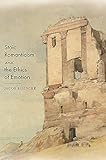Stoic Romanticism and the Ethics of Emotion / Jacob Risinger.
Material type: TextPublisher: Princeton, NJ : Princeton University Press, [2021]Copyright date: ©2021Description: 1 online resource (264 p.) : 1 b/w illusContent type:
TextPublisher: Princeton, NJ : Princeton University Press, [2021]Copyright date: ©2021Description: 1 online resource (264 p.) : 1 b/w illusContent type: - 9780691223117
- English literature -- 19th century -- History and criticism
- English literature-19th century-History and criticism
- Romanticism
- Stoics in literature
- LITERARY CRITICISM / Ancient & Classical
- A Vindication of the Rights of Men
- Aesthetics
- Altruism
- An Essay on Man
- Anacharsis
- Anecdote
- Antipathy
- Antithesis
- Apatheia
- Apathy
- Asceticism
- Bellum omnium contra omnes
- Byronic hero
- Character of the Happy Warrior
- Classical language
- Confidant
- Contingency (philosophy)
- Cosmopolitanism
- Critical and Historical Essays (Macaulay)
- Criticism
- Critique
- David Hume
- Defamiliarization
- Delusion
- Descriptive poetry
- Disenchantment
- Effeminacy
- Emotional detachment
- Equanimity
- Ethics
- Expressivism
- Falsity
- Fatalism
- Fears in Solitude
- Gentlewoman
- Historicism
- Houyhnhnm
- Hypocrisy
- Idealism
- Idealization
- Impartiality
- Inductive reasoning
- Indulgence
- Intentionality
- Invective
- Irony
- Lord Byron
- Lyrical Ballads
- Meditations
- Modern Moral Philosophy
- Moral Landscape
- Moral absolutism
- Moralia
- Morality
- Nihil admirari
- Noble savage
- Nonviolence
- Objectivity (philosophy)
- On Justice
- Overreaction
- Philosophy
- Pity
- Poetic diction
- Poetry
- Pragmatism
- Presentism (literary and historical analysis)
- Psychoanalysis
- Radical criticism
- Rationality
- Relativism
- Religiosity
- Res publica
- Ridicule
- Romanticism
- Sage (philosophy)
- Samuel Taylor Coleridge
- Satire
- Selfishness
- Sentimentalism (literature)
- Sentimentality
- Skepticism
- Soliloquy
- Solipsism
- Sophism
- Sophistication
- State of nature
- Stiff upper lip
- Stoic physics
- Stoicism
- Sublime (philosophy)
- Tabula rasa
- The Anatomy of Melancholy
- The Dispossessed
- The Power of Sympathy
- The Theory of Moral Sentiments
- Thought
- Truth
- Utilitarianism
- Value (ethics)
- Weltschmerz
- 820.9145 23
- PR457 .R4562 2021.
- PR451
- online - DeGruyter
| Item type | Current library | Call number | URL | Status | Notes | Barcode | |
|---|---|---|---|---|---|---|---|
 eBook
eBook
|
Biblioteca "Angelicum" Pont. Univ. S.Tommaso d'Aquino Nuvola online | online - DeGruyter (Browse shelf(Opens below)) | Online access | Not for loan (Accesso limitato) | Accesso per gli utenti autorizzati / Access for authorized users | (dgr)9780691223117 |
Browsing Biblioteca "Angelicum" Pont. Univ. S.Tommaso d'Aquino shelves, Shelving location: Nuvola online Close shelf browser (Hides shelf browser)

|

|

|

|

|

|

|
||
| online - DeGruyter French Literary Fascism : Nationalism, Anti-Semitism, and the Ideology of Culture / | online - DeGruyter The Cinema of Federico Fellini / | online - DeGruyter Modi's India : Hindu Nationalism and the Rise of Ethnic Democracy / | online - DeGruyter Stoic Romanticism and the Ethics of Emotion / | online - DeGruyter Indebted : How Families Make College Work at Any Cost / | online - DeGruyter Faithful and Fearless : Moving Feminist Protest inside the Church and Military / | online - DeGruyter Bardic Nationalism : The Romantic Novel and the British Empire / |
Frontmatter -- Contents -- Acknowledgments -- List of Abbreviations -- Introduction -- Chapter 1. Stoic Moral Sentimentalism from Shaftesbury to Wollstonecraft -- Chapter 2. Wordsworth and Godwin in “Frozen Regions” -- Chapter 3. Coleridge, Lyric Askesis, and Living Form -- Chapter 4. The True Social Art: Byron and the Character of Stoicism -- Chapter 5. Stoic Futurity in Sarah Scott and Mary Shelley -- Chapter 6. Emerson, Stoic Cosmopolitanism, and the Conduct of Life -- Notes -- Bibliography -- Index
restricted access online access with authorization star
http://purl.org/coar/access_right/c_16ec
An exploration of Stoicism’s central role in British and American writing of the Romantic periodStoic philosophers and Romantic writers might seem to have nothing in common: the ancient Stoics championed the elimination of emotion, and Romantic writers made a bold new case for expression, adopting “powerful feeling” as the bedrock of poetry. Stoic Romanticism and the Ethics of Emotion refutes this notion by demonstrating that Romantic-era writers devoted a surprising amount of attention to Stoicism and its dispassionate mandate. Jacob Risinger explores the subterranean but vital life of Stoic philosophy in British and American Romanticism, from William Wordsworth to Ralph Waldo Emerson. He shows that the Romantic era—the period most polemically invested in emotion as art’s mainspring—was also captivated by the Stoic idea that aesthetic and ethical judgment demanded the transcendence of emotion.Risinger argues that Stoicism was a central preoccupation in a world destabilized by the French Revolution. Creating a space for the skeptical evaluation of feeling and affect, Stoicism became the subject of poetic reflection, ethical inquiry, and political debate. Risinger examines Wordsworth’s affinity with William Godwin’s evolving philosophy, Samuel Taylor Coleridge’s attempt to embed Stoic reflection within the lyric itself, Lord Byron’s depiction of Stoicism at the level of character, visions of a Stoic future in novels by Mary Shelley and Sarah Scott, and the Stoic foundations of Emerson’s arguments for self-reliance and social reform.Stoic Romanticism and the Ethics of Emotion illustrates how the austerity of ancient philosophy was not inimical to Romantic creativity, but vital to its realization.
Mode of access: Internet via World Wide Web.
In English.
Description based on online resource; title from PDF title page (publisher's Web site, viewed 01. Dez 2022)


